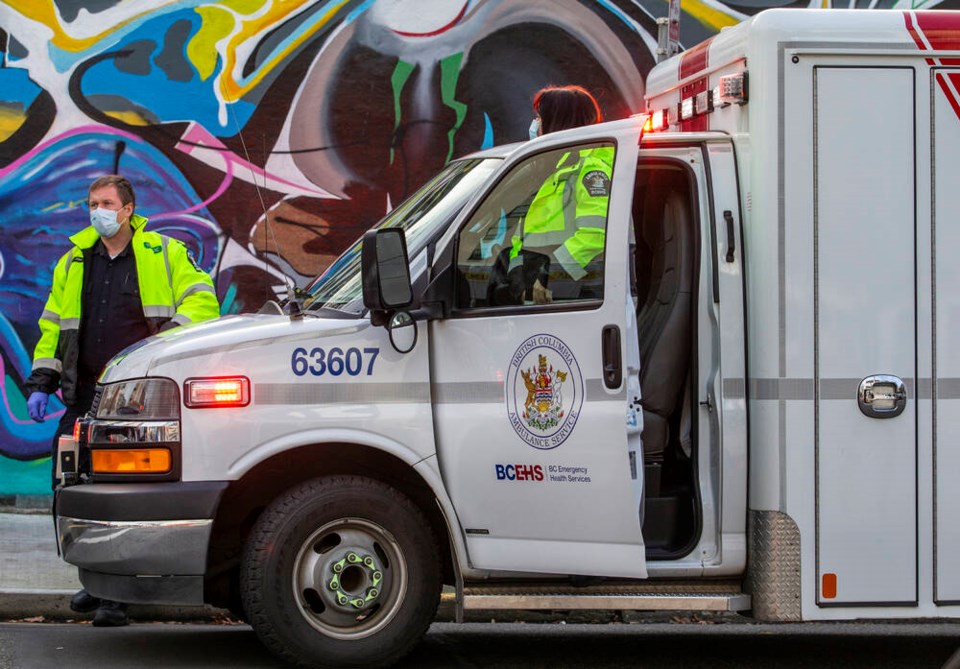B.C.’s ambulance service is sweetening the pot to lure experienced paramedics to understaffed rural communities with cash bonuses and paid expenses.
But veteran paramedics say a high-stress environment, low morale and inadequate pay are pushing some of their colleagues out of the profession. Others say not enough is being done to remove the barriers to becoming a paramedic, especially for those living in remote areas across the province.
Despite the NDP government’s overhaul of the ambulance service after last year’s deadly heat dome — which saw low-paid, on-call paramedics offered full- and part-time positions in rural communities — B.C. Emergency Health Services continues to face a shortage of paramedics, resulting in some ambulances being unstaffed or having to be pulled from small communities to cover other areas.
In at least three cases since July, people who went into cardiac arrest died while waiting for paramedics to arrive from a neighbouring community, including two seniors in Ashcroft and an infant in Barriere. BCEHS is reviewing all three incidents.
The ambulance service says it’s engaged in an intense recruitment drive to increase its ranks. It is also offering a $100-per-day bonus to paramedics in well-staffed areas who are willing to work between two and four weeks in rural communities. Their travel, accommodation and meal expenses would also be covered.
But a 10-year paramedic based in Kelowna said he’s not sure those incentives will be enough. The paramedic, who asked to remain anonymous because he feared career reprisals for speaking out, said morale is at an all-time low, partly because the staff shortages mean paramedics are burned out.
“You go from what should be a normal, manageable shift to doing 12, 13, 14 calls, getting run off your feet, not having any ALS [advanced life support] resources because scheduling [department] made a mistake and gave the only two ALS members holidays on the same day,” he said.
“I’m looking at my options as potentially applying to the fire department because why wouldn’t I want to make 30 per cent more and work 40 per cent less? It’s a no brainer.”
Sara Kendall, a B.C. paramedic and medical doctor currently completing her family practice residency in the U.S., said the key to addressing the paramedic shortage is removing barriers to entering the profession.
Most people in rural B.C. need to leave their communities to complete training and often struggle to pay the tuition, she said.
There are three B.C. schools to become licensed as a paramedic: the Justice Institute of B.C., Columbia Paramedic Academy and the AET Academy.
The primary care paramedicine program at JIBC can be completed full-time over eight months, including a four-month in-class component or on a part-time basis over 17 months.
The full-time program is offered in Victoria, New Westminster, Chilliwack and Kelowna and in intervals at some post-secondary institutions, such as North Island College in Port Alberni and Campbell River, and College of New Caledonia in Prince George.
The part-time program combines online learning with 16 weekend workshops located in various rural and regional sites across B.C. The program costs $6,250.
“So for young people, especially young people from working class backgrounds, [the fees] are untenable,” she said. “And it becomes doubly untenable for people from Indigenous communities, who in my viewpoint would be the most wonderful population to be the paramedics because the communities would be served by their own members.”
Rural mayors and the Ambulance Paramedics and Emergency Dispatchers of B.C., the union representing 4,500 paramedics, are advocating for more paramedic training courses in rural communities so people can become licensed closer to home.
BCEHS said it is doing just that, but it did not give details on where the expanded courses will be offered.
Once paramedics are trained and hired, Kendall said pay needs to be improved. Paramedic wages range from $28 an hour to $49 an hour.
Mike Savage, the fire chief in Blackpool, a community 10 kilometres from Clearwater, has seen how staff shortages can impact paramedics’ morale.
Savage said he has responded to several emergency calls in which a lone paramedic arrives with an ambulance but can’t transport to hospital because two paramedics are needed — one to drive the ambulance and one to stay in the back with the patient.
In at least three cases, a firefighter with level-three advanced first aid training and Class 4 driver’s licence, drove the ambulance to hospital while the paramedic attended to the patient in the back, Savage said.
“We’ve had this happen three times and local paramedics have been written up by their superiors because they’ve violated the policy, but it saved a life,” said Savage, a former RCMP staff sergeant who retired from Kamloops RCMP in 2016.
“To me that’s ludicrous.”
>>> To comment on this article, write a letter to the editor: [email protected]



